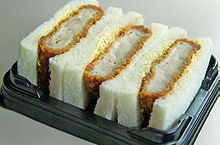Tonkatsu
show This article may be expanded with text translated from the corresponding article in Japanese. (January 2020) Click [show] for important translation instructions. |
 Tonkatsu | |
| Place of origin | Japan |
|---|---|
| Region or state | East Asia |
| Main ingredients | Cutlet (pork fillet or loin), cabbage, miso soup |
Tonkatsu (豚カツ, とんかつ or トンカツ, pronounced [toŋkatsɯ]; "pork cutlet") is a Japanese dish that consists of a breaded, deep-fried pork cutlet. It involves coating slices of pork with panko (bread crumbs), frying them in oil, and then serving with rice and shredded cabbage. The two main types are fillet and loin. Tonkatsu is also the basis of other dishes such as Katsukarē and katsudon.
Etymology[]
The word tonkatsu is a combination of the Sino-Japanese word ton (豚) meaning "pig", and katsu (カツ), which is a shortened form of katsuretsu (カツレツ), the transliteration of the English word cutlet,[1] which again derived from French côtelette, meaning "meat chop".
History[]
Tonkatsu originated in Japan in the 19th century. Early katsuretsu was usually beef; the pork version was invented in Japan in 1899 at a restaurant called Rengatei in Tokyo.[2][3][4] It was originally considered a type of yōshoku — Japanese versions of European cuisine invented in the late 19th and early 20th centuries—and was called katsuretsu or simply katsu.[5]
Preparation and serving[]

Either a pork fillet (ヒ���, hire) or pork loin (ロース, rōsu) cut may be used; the meat is usually salted, peppered, dredged lightly in flour, dipped into beaten egg and then coated with panko (bread crumbs) before being deep fried.[6]
Tonkatsu is then sliced into bits and served with shredded cabbage.[6][7] It is most commonly eaten with a type of thick brown sauce called tonkatsu sauce[6] or simply sōsu (sauce), karashi (mustard), and perhaps a slice of lemon. It is usually served with rice, miso soup and tsukemono and eaten with chopsticks. It may also be served with ponzu and grated daikon instead of tonkatsu sauce.[8]
Variations[]



In Nagoya and surrounding areas, miso katsu, tonkatsu eaten with a hatchō miso-based sauce, is a speciality.[9]
Variations on tonkatsu may be made by sandwiching an ingredient such as cheese or shiso leaf between the meat, and then breading and frying. For the calorie conscious, konnyaku is sometimes sandwiched in the meat.[citation needed]
Several variations of tonkatsu use alternatives to pork:
- Chicken katsu (チキンカツ) or Tori katsu (鶏カツ), which uses chicken instead, often appears in Hawaiian plate lunches.
- Menchi-katsu (メンチカツ) or minchi katsu (ミンチカツ mince katsu), is a minced meat patty, breaded and deep fried.
- Hamu katsu (ハムカツ ham katsu), a similar dish made from ham, is usually considered a budget alternative to tonkatsu.
- Gyū katsu (牛カツ beef katsu), also known as bīfu katsu, is popular in the Kansai region around Osaka and Kobe.
In general, breaded and deep-fried foods are called furai (frys). Furai of mammal or bird meats, such as pork, beef, or chicken are called katsu (cutlet). Furai of ingredients other than that are just called furai,[10] such as aji-furai (fried horse mackerel) and ebi-furai (fried prawn).
Tonkatsu and other furais are never called tempura. Tempura is not breaded,[11] and is not seen as a kind of furai.
Tonkatsu is also popular as a sandwich filling (katsu sando), or served on Japanese curry to become katsukarē. Tonkatsu is sometimes simmered with egg and broth, then served on a big bowl of rice as katsudon.
See also[]
- Japanese cuisine
- List of Japanese dishes#Deep-fried dishes (agemono, 揚げ物), a category of deep-fried dishes in Japanese cuisine
- List of pork dishes
- Schnitzel
References[]
- ^ "Katsuretsu" カツレツ [cutlet]. Nihon Kokugo Daijiten Concise edition, web version (精選版 日本国語大辞典) (in Japanese). Shogakukan. Retrieved 2021-08-16 – via kotobank.jp.
cutlet [... shortened form is] "katsu".
- ^ 岡田, 哲. とんかつの誕生―明治洋食事始め. p. 166.
- ^ 小菅, 桂子. にっぽん洋食物語大全. p. 122.
- ^ Kaneko, Amy (2007). Let's Cook Japanese Food!: Everyday Recipes for Home Cooking. Chronicle Books. p. 101. ISBN 978-0-8118-4832-9.
- ^ Jennifer Ellen Robertson, ed. (2005). A companion to the anthropology of Japan. Wiley-Blackwell. p. 421. ISBN 0-631-22955-8.
- ^ Jump up to: a b c Tsuji, Shizuo; Fisher, M. F. K. (2007). Japanese Cooking: A Simple Art. Kodansha International. p. 240. ISBN 978-4-7700-3049-8.
- ^ Hosking, Richard (1995). A Dictionary of Japanese Food - Ingredients and Culture. Tuttle. p. 159. ISBN 0-8048-2042-2.
- ^ Ono, Tadashi; Salat, Harris (2013). Japanese Soul Cooking: Ramen, Tonkatsu, Tempura, and More from the Streets and Kitchens of Tokyo and Beyond. Potter/Ten Speed/Harmony/Rodale. ISBN 9781607743538. Retrieved 21 July 2020.
- ^ http://www.nic-nagoya.or.jp/en/e/archives/629
- ^ "Furai (ryouri)" フライ (料理) [Fry (cooking)]. Encyclopedia Nipponica web version (in Japanese) (constantly updated ed.). Shogakukan. Retrieved 2021-08-16 – via kotobank.jp.
(rough translation): In Western cuisine, "frying" means to deep-fry or sautee in oils or fats. [...] In Japan, "furai" refers to foods that are dipped in wheat flour, beaten egg, bread crumbs and then deep-fried, [...]. If the ingredient is meat, it is called "chikin katsuretsu", "pōku katsuretsu (tonkatsu)" etc., respectively.[...]
- ^ No panko appears in definition of tempura: "Tempura" 天麩羅 テンプラ. Digital Daijisen (デジタル大辞泉) (in Japanese) (constantly updated ed.). Shogakukan. Retrieved 2021-08-16 – via kotobank.jp.
(rough translation): 1.[...ingredients] dipped in batter made of wheat flour, egg and water, then fried in vegetable oil. Vegetable tempuras are somtimes distinguished and called "shōjin-age". [...]
External links[]
| Wikibooks Cookbook has a recipe/module on |
| Wikimedia Commons has media related to Tonkatsu. |
- Breaded cutlets
- Deep fried foods
- Japanese fusion cuisine
- Japanese pork dishes
- Sandwiches
- Fried pork

